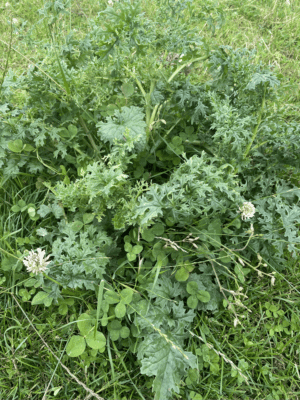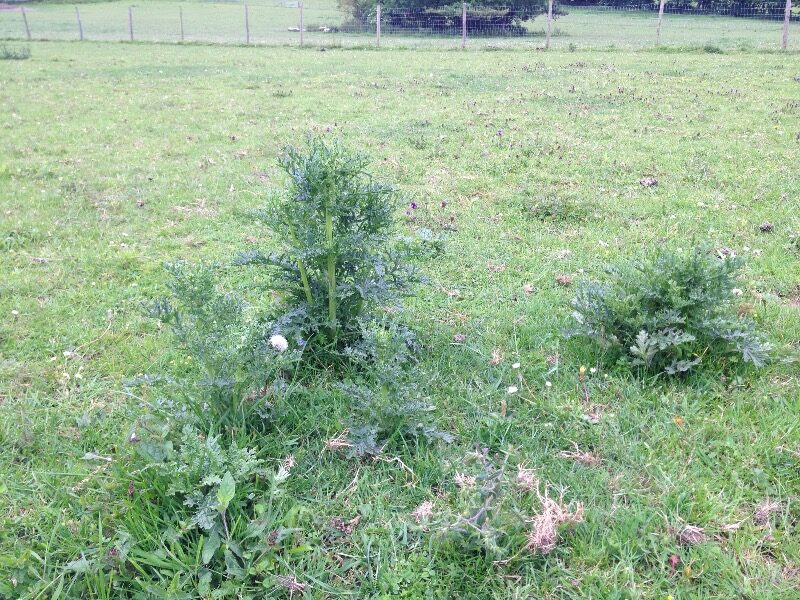Nutrition
What’s in your field?
Briony Witherow takes a look at what may be growing alongside the grass in your field
Often, grass is not the only thing growing rapidly in and around our fields. While most would be considered weeds, not all should be dismissed completely when it comes to your horse’s diet. Horses, while generally seen as grazers, are competent browsers and will often thrive on the variety provided by other plants growing in or around our pasture. As horse owners, the key is to know what we need to be wary of and, what we can view as useful enrichment.
The devil is in the detail
When it comes to identifying what is in your field there are many plants which look very similar but crucially, while one may be perfectly suitable, another may be poisonous to you and your horse! A good example of this is cow parsley and hemlock.
As you can see from the image, both look very similar, however, upon closer inspection, there are subtle differences in the leaves (hemlock being shiny, cow parsley dull) and in the shape and colouring of the stem; hemlock has red/purple blotches while cow parsley has distinctive celery-like grooves on the stem.
Best avoided
Common ragwort (Senecio jacobea) Ragwort is a well-known poisonous plant affecting horses, with common ragwort (Senecio jacobea) being the most widespread and associated with poisoning of horses and other grazing animals¹ ². UK based surveys estimate a frequency of ragwort in horse pastures of 55-84% ³ ⁴, making it a key concern for all horse owners.
Ragwort becomes more palatable when dried, its poisonous pyrrolizidine alkaloids (PAs), unaffected by the conservation process, making risk of ingestion higher when conserved as hay ⁵ ⁶ ⁷ or, where animals have access to fields too soon after herbicides are applied⁶ ⁷.
Other alkaloid containing plants to avoid are hemlock (Conium Maculatum) – easily mistaken for cow parsley – and groundsel (Senecio Vulgaris) ⁸.


Ragwort Left: Characteristic ragwort ‘rosette’; Right: Ragwort often grows to the height of the plants around it

Oak tree (Quercus)
Oak trees, particularly immature buds and acorns contain tannins, which when eaten produce toxins poisonous to horses⁹.The period of highest risk in the UK is during spring (ingestion of buds and young leaves) and in the autumn (ingestion of acorns). While most horses do not consume large quantities, research suggests some horses are more at risk of acorn poisoning than others and, that the toxicity of the acorns is thought to vary year by year¹⁰. Where oak trees lie within or border horse paddocks, fence off the area during high-risk periods and, consider those with restricted grazing as high-risk due to the lack of alternative forage ¹⁰.
Sycamore tree (Acer pseudoplatanus)
Seeds from acer species such as the sycamore contain a substance called hypoglycin A¹¹, ingestion of which can cause atypical myopathy (an often-fatal muscle disease)¹¹ ¹².
While research suggests most cases of poisoning occur in the autumn, resulting from ingestion of seeds, incidence has also been reported in the spring after ingestion of seedlings. Much like oak trees, proactive measures to prevent ingestion are strongly advised¹³ through fencing-off areas at high-risk times or, removing such trees from the perimeter of horse paddocks. Another notable group of plants to avoid are those containing cardiac glycosides such as foxgloves (Digitalis purpurea)¹⁴.
While these are thought to be bitter tasting and therefore generally avoided, removal or fencing-off from horses is recommended.
Best minimised
Buttercups
There are five types of buttercup that can be found in the UK. These tend to be a problem when grass cover is compromised. As with many poisonous plants, significant quantities typically need to be ingested to cause a problem. Creeping buttercups (Ranunculus repens) can be toxic to horses and are indicative of poor pasture, buttercups thrive in acidic, poached or compacted soils. Due to its obvious appearance when in flower, this weed is often forgotten about until this point, although control is more effective prior to flowering. All parts of the plant contain glycoside ranunculin however, the highest concentration is at flowering¹⁵.
When the plant is conserved in hay/haylage it becomes less toxic⁷. Due to their bitter taste, buttercups tend to only be eaten where no alternative is available or, where infestation is so marked that consumption is inevitable⁷. Buttercups are the opposite of ragwort, which is less toxic when flowering and more so when they have died back.
Appropriate in moderation
Clover (Trefoil)
Clover is a common sight in many horse pastures throughout the UK. White (Trifolium repens) and red clover (Trifolium pratense) are the most common types you may come across in your field; the former perhaps being the most common, as it is more tolerant of close grazing.
Clover is a legume and comes from the same ‘family’ as lucerne (alfalfa) and with it, comes some similar traits making it not only valuable nutritionally (higher in protein, energy, and calcium in comparison to grasses) but also valuable for the grassland itself, with its ability to ‘fix’ atmospheric nitrogen into the soil.
While the research would typically support a strong association between white clover and palatability¹⁶, it is possible to have ‘too much of a good thing’ and where clover becomes the dominant species, representing a significant proportion of the ground cover, this becomes undesirable for horses. Anecdotally, a maximum of 20% ground cover as clover in a field is well tolerated. done to laminitis¹⁷. Too much clover, or exposure to clover, which has accumulated moulds (and subsequently mycotoxins) can also be a cause for concern and has been associated with symptoms such as increased salivation, photosensitivity, liver disease and foetal loss
Cow parsley (Anthriscus sylvestris)
Cow parsley with its distinctive white umbellifer (umbrella-like cluster of small white flowers), is often found at field edges and in latrine areas in horse pasture. As mentioned previously, it can be confused with hemlock or common hogweed (Heracleum sphondylium); both having a similar white flower but, with subtle differences in the stem and leaves. Note that the leaves of cow parsley and hemlock both have a ‘feathered’ appearance (being a member of the carrot family – this leaf shape may be familiar to gardeners) while the leaf of hogweed is considerably wider.
The other distinctive feature is growing season – in the UK, while cow parsley and emlock appear from May to June (disappearing as I write this), common hogweed continues later into the summer until around August. These are important distinctions, as while cow parsley and common hogweed can be consumed by horses, hemlock is known to be poisonous.
Do be aware of giant hogweed (Heracleum mantegazzianum); very similar to common hogweed but as the name would suggest much larger in size with a distinctive purple spotted stem. This should be avoided, its sap having the potential to cause burns to the skin.
Other common plants which may appear in fields or the hedges surrounding them that are thought to be suitable in moderation (although in many cases this is anecdotal) include:
- Thistles There are many different types, the most common being spear and creeping thistles. Horses tend to eat the growing flower buds on spear thistles, and these are thought to be mineral rich.
- Common nettle (Urtica dioica). Horses enjoy wilted nettles. They are thought to be rich in vitamins, minerals and protein and commonly included in herbal supplements.
- Cleavers (Galium aparine). These can be found in herbal supplements and have been attributed with lymphatic and urinary system benefits. These are also known as sticky weed, and are commonly found in hedgerows.
Hawthorn, hazel, blackthorn, blackberry leaves and bramble will also be commonly browsed by horses from the hedgerows.
Management to moderate intake
Good pasture management is key to preventing an over-representation of unwanted weeds and too much clover in your fields.
Left to right: Clover; cleavers; nettles
Minimise compaction and promote adequate periods of rest Avoiding overstocking and taking into account time of year, soil type and the purpose of the field when making decisions on stocking density is key. Overgrazing should also be kept to a minimum where possible. You can employ grazing systems such as rotational grazing, which will help to maximise grass ‘yield’ and in doing so reduce clover and weeds. Rotational grazing works well, but essentially any method, which allows grass time to recover and does not facilitate overgrazing to the point of grass damage will help (such as strip grazing). Keep the soil healthy Both weeds and clover tend to thrive in conditions where grass does not. Optimising the soil condition to suit grass by checking the pH (how acid or alkaline the soil is) and nutrient levels (fertility of the soil) can be beneficial. Grass will typically thrive at a soil pH of between 6-7 and needs relatively fertile soil, to reduce ‘stress’ and and encourage ground cover.
References
1. Leyland, A. (1985) Ragwort poisoning in horses. Veterinary Record 117, 479
2. Elcock, L. and Oehme, F.W. (1982) Senecio poisoning in horses: a summary. Veterinary and Human Toxicology 24, 2-3
3. British Horse Society/DEFRA (2014) file:///Users/brionywitherow/Downloads/BHS%20Defra%20Ragwort%20Summary%20Research%20Report%202014.pdf Accessed: 20th June 2021
4. National Equine Health Survey (2014) https://www.bluecross.org.uk/sites/default/files/downloads/NEHS%20report%202014.pdf Accessed: 20th June 2021
5. McDowell, D.M. (1999) Ragwort poisoning in horses. Veterinary Record 145, 48
6. Giles, C.J. (1983) Outbreak of ragwort (Senecio jacobea) poisoning in horses. Equine Veterinary Journal, 15 (3): 248-250
7. Barr, C.A.,and Reagor, J.C. (2001) Toxic Plants: What the horse practitioner needs to know. Veterinary Clinics of North America: Equine Practice, 17 (3): 529-546
8. Cortinovis, C., and Caloni, F. (2015) Alkaloid-containing plants poisonous to cattle and horses in Europe. Toxins, 7: 5301-5307
9. Broughton, J.E. (1976) Acorn poisoning. Vet Record, 99:403–404
10. Smith, S., Naylor, R.J., Knowles, E.J., Mair, T.S., Cahalan, S.D., Fews, D., and Dunkel., B. (2015) Suspected acorn toxicity in nine horses, Equine Veterinary Journal, 47: 568-572
11. Votion, D-M. (2016) Atypical myopathy: an update. In Practice, 38 (5): 241-246
12. Gonzalez Medina, S., Hyde, C., Lovera, I., Piercy, R.J. (2018) Detection of equine atypical myopathy-associated hypoglycin A in plant material: optimisation and validation of a novel LC-MS based method without derivatisation. PLOS ONE, 13 (7): e0199521. https://doi.org/10.1371/journal.pone.0199521
13. Votion, D-M., Habyarimana, J.A., Scippo, M-L., Richard, E.A., Marcillaud-Pitel, C., Erpicum, M., and Gustin, P. (2019) Potential new sources of hypoglycin A poisoning for quids kept at pasture in spring: a field pilot study. Vet Record, 184 (24): 740-740
14. Wijnberg. I.D., van der Kolk, J.H. and Hiddink, E.G. (1999) Use of phenytoin to treat digitalis-induced cardiac arrythmias in a miniature Shetland Pony. Vet Record, 144 (10): 259-261
15. Hill, R. and Vann Heyningen, R. (1951) Ranunculin; the precursor of the vesicant substance of the buttercup. The Biochemical Journal, 49 (3): 332-335
16. Archer, M. (1973) The species preferences of grazing horses. Grass and Forage Science, 28 (3): 123-128
17. Almeida, J.P.F. (2012) White Clover (Trifolium repens L.): Do non-structural carbohyrates account? In: Saastamoinen M., Fradinho M.J., Santos A.S., Miraglia N. (eds) Forages and grazing in horse nutrition. Forages and grazing in horse nutrition, vol 132. Wageningen Academic Publishers, Wageningen
18. McDowell, K., Allman, R., Henning, J.(2002) Phytoestrogens and estrogenic activity in white clover samples from no-loss and high-loss fields during mare reproductive loss syndrome. In: Powell, D.G., Troppmann, A., Tobin, T., (eds): Workshop on Mare Reproductive Loss Syndrome. Lexington, KY, University of Kentucky College of Agriculture
19. Elghandour, M.M.M.Y., Reddy, P.R.K., Salem, A.Z.M., Redyy, P.P.R., Hyder, I., Barbabosa-Pliego, A., and Yasaswini, D. (2018) Plant bioactives and extracts as fed additives in horse nutrition. Journal of Equine Veterinary Science, 69: 66-77.

